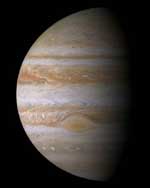Jupiter’s moon Io is peppered with volcanoes, the hottest, most active volcanoes in our solar system. Sizzling vents spew plumes of gas and dust as much as 400 km high. They surge, spit, subside and surge again, non-stop.
The towering plumes, outlined by graceful arcs of rising and falling ash, are eerily beautiful. Their tops jut into space, freezing. Beneath them, scientists believe, it snows. Sulfurous flakes crystallize in the plume-tops and drift gently down to coat Io’s colorful terrain.
High above the falling snow something unexpected happens: At the apex of the plumes, some of the ash and dust that ought to turn around and fall … doesn’t. Defying gravity, it keeps going up, not slowing but accelerating, 2 times, 10 times, hundreds of times faster than a speeding bullet, away from Io and into deep space.
Passing spacecraft beware: Io is shooting at you.
The Ulysses spacecraft, a joint mission of NASA and the European Space Agency, made the discovery in 1992 when, approaching Jupiter, it was hit by a breakneck stream of volcano dust.
“What a surprise,” recalls Harold Krueger of the Max Planck Institute in Heidelberg, the principle investigator for Ulysses’ dust detector. “We expected to encounter dust,” he says. The solar system is littered with flakes from comets and asteroids. “But nothing like this.”
The dust came in a tight stream, like water from a garden hose, and it was moving extraordinarily fast, about 300 km/s (670,000 mph). “This makes it some of the fastest-moving material in the solar system,” says Krueger, “second only to the solar wind.” Fortunately the dust-bits were small, similar in size to particles in cigarette smoke, so they didn’t penetrate the ship’s hull in spite of their extreme velocity.
At first, no one suspected Io. Ulysses was 100 million kilometers from Io when the stream blew by, supposedly beyond the reach of volcanic plumes. Plus, the speed of the dust didn’t make sense. Particles emerge from Io’s vents traveling 1 or 2 km/s, not 300 km/s.
Baffled, researchers considered several possibilities: Could Jupiter’s dark rings be responsible? There’s plenty of dust there, but how could rings manufacture fast-moving jets? Comet Shoemaker-Levy 9 was another suspect. The comet flew so close to Jupiter in 1992 that it was torn apart. Comets are known to produce streams of dust, but not so fast as the stream that hit Ulysses.
NASA’s Galileo spacecraft eventually solved the puzzle. Like Ulysses, Galileo was pelted by dust when it approached Jupiter in 1995. Unlike Ulysses, which merely flew past the giant planet, Galileo settled into orbit. As data accumulated over a period of years, scientists were able to correlate volcanic activity with dust events, and they showed, furthermore, that dust streams were modulated by Io’s orbital motion.
The source was definitely Io.
Regarding the extreme velocity of the dust: “Jupiter is responsible for that,” explains Krueger.
Jupiter is not only a giant planet, but also a giant magnet, which spins once every 9 hours and 55 minutes. Spinning magnetic fields produce electric fields, and the electric fields around Jupiter are intense. Io-dust, like dust on your computer monitor, is electrically charged, so Jupiter’s electric forces naturally accelerate the grains. 300 km/s is no problem.
In 2000 when the Cassini spacecraft sailed past Jupiter en route to Saturn, it too was hit. Cassini’s dust detector is more capable than Ulysses’. In addition to mass, speed, charge and trajectory, it can also measure elemental composition. Cassini found hints of sulfur, silicon, sodium and potassium–all signs of volcanic origin.
“This raises an interesting possibility,” says Krueger. “We can analyze the hot interior of Io from a great distance.” There’s no need to get too close to the sizzling vents when you can catch the ash millions of miles away.
Io dust can even reach Earth, says Krueger, but don’t expect a meteor shower. Bright meteors such as Perseids and Leonids are caused by sand-sized comet dust. Io dust is much smaller. A typical grain is only 10 billionths of a meter wide. If a bit of it disintegrated in Earth’s atmosphere, you probably wouldn’t notice.
End of story? Not quite.
Ulysses visited Jupiter again in early 2004 and once again the craft was pelted. Io’s volcanoes were still at work. But something was wrong: The dust was shooting in the wrong direction.
“Io dust is supposed fly out of Jupiter’s equatorial plane,” says Krueger, “because that’s the way the accelerating electric fields point.” This time Ulysses approached Jupiter’s north pole (75 degrees north latitude to be exact) where no dust should go. Yet the spacecraft was pelted anyway.
Jupiter, it seems, flings Io-dust in every direction, which is hard to understand, says Krueger. Future missions to the giant planet might unravel the mystery. Every blast of dust will remind: we’ve still got a lot to learn.
Original Source: NASA Science Article








